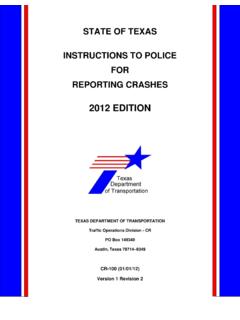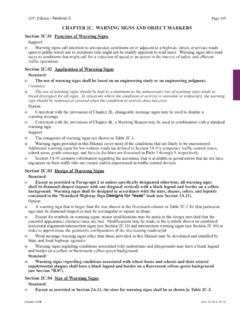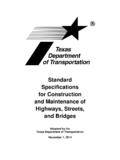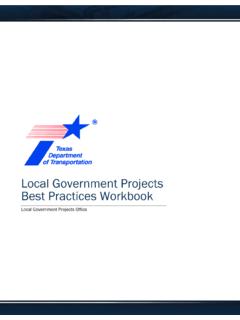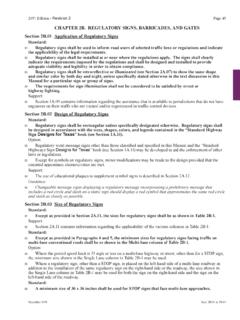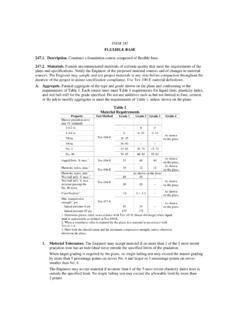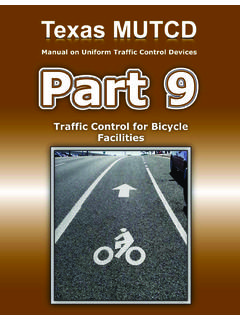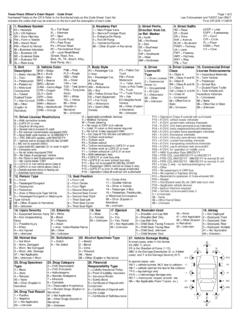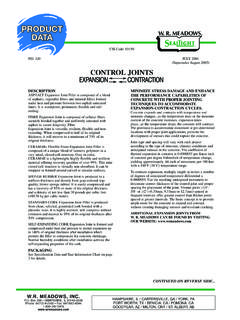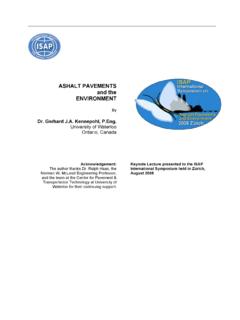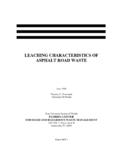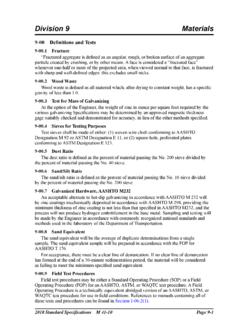Transcription of BRIDGE EXPANSION JOINTS - ftp.dot.state.tx.us
1 ITEM 454 BRIDGE EXPANSION JOINTS Description. Furnish and install BRIDGE EXPANSION JOINTS . Materials. Provide materials in accordance with the requirements of the following Items: Item 442, Metal for Structures DMS-6140, Elastomeric Concrete for BRIDGE joint Systems DMS-6310, joint Sealants and Fillers, Class 7 (Low-Modulus Silicone, Rapid-Curing, Self-Leveling) ASTM D-5973, Standard Specification for Elastomeric Strip Seals with Steel Locking Edge Rails Used in EXPANSION joint Sealing. If required, use primers recommended by the manufacturer of the sealant. Use backer rods compatible with the sealant that do not react or bond together. Construction. Place EXPANSION JOINTS to conform to the finished grade of the roadway surface.
2 Set the joint opening at the dimension shown on the plans for 70 F, adjusted for the temperature at the time of installation. For sealed joint openings, place the seal for the full length of the joint and, when required, extend it into the parapet wall on the low side or sides of the BRIDGE . A. Sealed EXPANSION joint (SEJ). Choose an approved joint system that conforms to the joint type and the design requirements shown on the plans. Secure each side of the joint by welding it to the adjacent reinforcing steel or other attachments as approved. Remove any connection holding the joint halves together immediately after each joint half is secured in place. Install the neoprene seal as a continuous piece to form a watertight seal. B. Armor joint . Place steel armor plates as shown on the plans.
3 Secure each side of the joint by welding it to adjacent reinforcing steel or other attachments as approved. Remove any connection holding joint halves together immediately after each joint half is secured in place. Seal the joint when specified. Abrasive blast clean the vertical faces of the steel plates where the sealant will be in contact to remove all visible rust, paint, mill scale, and other forms of contamination, leaving a white metal appearance. Clean the concrete in contact with the sealant by an approved method in accordance with the manufacturer s specifications before placing sealant. After cleaning, air-blast the joint to remove all dust. Place sealant in accordance with the manufacturer s specifications and as shown on the plans. Repair damage to paint protection system above the seal when shown on plans for steel armor plates to be painted.
4 C. Header-Type EXPANSION joint . Meet with the manufacturer s representative and the Engineer to discuss the required installation procedures of the materials before beginning the work. Perform the work in accordance with the manufacturer s printed instructions and as discussed in the meeting. 1. Header. Create the required void in the concrete surface or asphalt overlay to accept the header material in accordance with the details shown on the plans. Extend the depth of the void in the asphalt overlay to sound concrete. Remove any unsound steel or concrete and repair concrete in accordance with Item 429, Concrete Structure Repair. Use header material as repair material only when approved. Clean the voided region of all materials that could inhibit the bond between the header material and concrete or steel.
5 Form the joint opening to the required width shown on the plans. Do not place materials until approved. Place material on a clean, sound, and dry base when the ambient temperature is at least 45 F and rising or as required by the manufacturer. Do not place material on wet substrate or when raining. Cure for the duration required by the manufacturer prior to opening to traffic. Tool or grind the upper corner of the header adjacent to the opening to a 1/4-in. radius. 2. Sealant. Clean the joint opening of forming material, existing seal, and other material that will inhibit the bond between the header material and the sealant. Abrasive blast clean surfaces in contact with the sealant. Place an approved backer rod and the sealant as shown on the plans.
6 Place sealant when ambient temperature is rising and is between 55 F and 85 F to provide for adequate joint opening and compression of the sealant during curing. Measurement. Sealed EXPANSION JOINTS and armor JOINTS will be measured by the foot. Header-type EXPANSION JOINTS will be measured by the foot or by the cubic foot of header material and foot of sealant. Length measurement will be along the centerline of the joint at the surface of the roadway and up into the parapet. Calculate volume for header-type EXPANSION JOINTS using the length and width shown on the plans and the header depth measured in place. Sealed EXPANSION JOINTS and armor JOINTS are a plans quantity measurement Item. The quantity to be paid is the quantity shown in the proposal unless modified by Article , Plans Quantity Measurement.
7 Additional measurements or calculations will be made if adjustments of quantities are required. Payment. The work performed and materials furnished in accordance with this Item and measured as provided under Measurement will be paid for at the unit price bid for Sealed EXPANSION joint of the size (minimum total movement capacity) and designation specified, Armor joint , Armor joint (With Seal), and Header-Type EXPANSION joint . Sealing the joint will be subsidiary to these items with the exception of the header-type EXPANSION joint when the header is paid for by volume measurement. This price is full compensation for furnishing and installing the joint systems including steel; and for materials, tools, equipment, labor, and incidentals.
8 If volume measurement for the header material is specified, the header material will be paid for at the unit price bid for Header-Type EXPANSION joint and the sealant will be paid for at the unit price bid for joint Sealant. This price is full compensation for furnishing and installing the joint systems and for materials, tools, equipment, labor, and incidentals.

